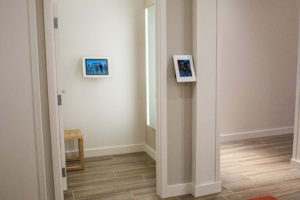Fabletics has grown in many directions since its launch less than a decade ago in 2013, says Ron Harries, senior vice president, head of retail for the activewear brand. It added stores to its mix in 2015 and now operates 55 nationwide. It has 2.3 million subscribers to its membership program and generates more than $500 million in total annual revenue.
Beyond growing stores, subscribers and sales, Fabletics—part of TechStyle Fashion Group, No. 59 in the Digital Commerce 360 2021 Top 1000—also has grown its omnichannel offerings over the years. That’s in part to try and entice its customers to shop across channels. Customers who shop in more than one channel spend 2.5 times more than those who stick to one, Harries says.
Its biggest leap into omnichannel was the launch of its homegrown technology called OmniShop, which brings digital technology, not only into physical stores but directly into a shopper’s dressing room. The technology enables Fabletics to track every item that a consumer brings into a dressing room via iPads both outside and inside dressing rooms that scan the products.
This allows Fabletics to quickly track what caught a consumer’s eye enough to try it on and what she tried on but didn’t purchase, Harries says. Additionally, if the consumer in a store is a member to the retailer’s subscription program—and Harries says 70% of store shoppers are either current members or become members during their store visit—any items brought into a dressing are placed into the shopper’s cart and saved, in case she wants to buy the products later online.

Ron Harries, senior vice president, head of retail for Fabletics
That feature can be a big bonus for Fabletics subscribers as Fabletics members must visit the site between the 1st and 5th of the month to purchase or skip the month. If they don’t take one of those actions, they are charged $49.95, which goes into an account that they can spend from when they find something they do want to purcahse. Offering members the ability to access what they tried on in a store later online can help move along a sale, Harries says. For example, a store shopper may be in a hurry to get back to work or may simply want to think a little more before pulling out her credit card. That saved online cart helps her easily complete her purchase when she is ready, Harries says.
Shoppers in many stores can also use iPads to ping associates for new sizes and colors or to stop by and provide style advice, Harries says. Fabletics also offers an endless aisle, or the ability for a shopper to order online from an iPad an item that isn’t in stock in that store but is available in one of Fabletics’ ecommerce warehouses.
The OmniShop technology enables Fabletics to get instant info on what items are eye-catching enough to get shoppers to try them on. “In stores, we know in the first half of a day that a new item launches if it is going to be popular,” Harries says. Fabletics launched the technology in 2017. All new stores get the full suite of OmniShop features and 35 out of Fabletics’ 55 stores currently enable shoppers in fitting rooms to request help from store employees.
Data suggests the technology is working to increase Fabletics’ valuable cross-channel shopper base. Today, Harris says 50% of its members shop both online and in stores. In 2017, when the technology first launched, that figure was around 15%.

OmniShop technology enables Fabletics to track every item that a consumer brings into a dressing room via iPads both outside and inside dressing rooms that scan the products.
Additionally, having a membership program where shoppers sign up for a subscription and log in to initiate actions, such as purchases, returns and exchanges, enable Fabletics to track consumer behavior very closely, Harries says. And that’s how Harries knows that buy online, return in store—another omnichannel feature Fabletics offers—surged with COVID-19, though he won’t say by how much.
“[Buy online, return or exchange in store increases] likely came out of the closures,” Harries says. “We’ve been able to track that very closely. It’s been very popular and the store/exchange rate has gone up. It’s probably because people that would have shopped in stores couldn’t.”
The retailer closed all its stores on March 16, 2020. Currently, all stores have now been open for at least three months, Harries says. One of Fabletics’ biggest challenges during COVID-19 was keeping stores adequately staffed. Fabletics had a policy to alert store associates if a coworker disclosed she was getting tested for COVID-19. It then gave all store associates the option to stay home until the worker got her results while still receiving their paychecks. If a large number of associates chose to stay home, Fabletics would have to temporarily close a store.
During the coronavirus, Fabletics also introduced store appointment selling before and after traditional store hours. “During challenging parts of COVID, we would offer that and some stores still offer it. It became a large part of our business,” he says without revealing more.
And the retailer’s omnichannel work is far from done, Harries says. Fabletics also plans to launch buy online, pick up in store in the next month ahead of the holiday rush. And, he says, buy online, ship from store and store self-checkout in store are both “on the roadmap.”
Such omnichannel shopping options are resonating more with shoppers, data suggests.
Nearly half (43%) of consumers said they said they had ordered an item for in-store pick up in the last six months, according to a February Digital Commerce 360 Bizrate Insights survey of 1,052 shoppers, up from 41% a year earlier. And curbside showed major growth, with 35% of shoppers having used the service, compared with 13% a year earlier. Additionally, 28% had used a store’s pickup parking space, up from 17% a year earlier. And even more telling for retailers, a good amount of consumers plan to do more omnichannel shopping. For example, 33% of shoppers surveyed planned to do more in store pickup in the next six months, 27% more curbside or drive up and 23% planned to use stores’ handy pickup parking spaces more often. Shoppers cited convenience (50%) and saving time (46%) as the top reasons for using BOPIS and curbside.
Consumers also are likely using BOPIS and curbside more because more retailers are offering it. In 2019, 201 Digital Commerce 360 Top 1000 retailers offered buy online, pick up in store. In 2020, 240 did—a 19.9% increase. And curbside pick up growth skyrocketed over the same timeframe. A mere 15 retailers offered it in 2019 and that number swelled to 174 in 2020, a 596% increase.
Favorite